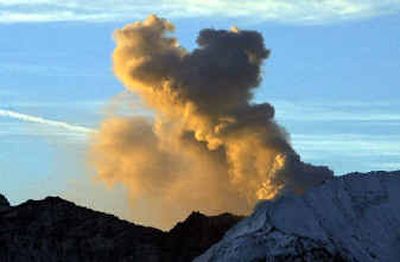St. Helens grows heated

MOUNT ST. HELENS, Wash. – New thermal images reveal that parts of the lava dome in Mount St. Helens’ crater are piping hot, and scientists are seeing signs that magma continues to rise.
Scientists said an area on the south side of the old dome, where a large uplift of rock has been growing, now appears perforated as if magma has been hammering at the surface.
“What’s happened in the last day is the magma is not just pushing up but pushing out. We no longer have just isolated vents, instead the whole area is pushing up, the gas is the fuse, just oozing out,” John Pallister, a U.S. Geological Survey geologist, said at a news conference Monday afternoon. He said scientists have not actually seen the magma, which they believe is less than half a mile below the surface.
Fast-moving magma would cause greater concern because explosive gases wouldn’t have time to dissipate. A team in Denver is evaluating air photos, comparing pictures of the changing lava dome to gauge how fast the magma is rising.
The alert level remains at “volcano advisory,” but scientists have said an eruption could occur with very little warning.
Pallister said the most likely scenario remains an explosion with a few inches of ash spreading out within a 10-mile radius of the crater. Such an event could happen in days, weeks or months – or not at all, he said. Scientists believe the chance of a larger eruption like the one on May 18, 1980, which killed 57 people, is slim.
Any eruption would likely be vertical instead of the devastating horizontal blast that leveled old-growth trees for miles around in 1980.
Willie Scott, a U.S. Geological Survey geologist, said earlier Monday that temperatures in some spots could be as high as 200 to 300 degrees Celsius – roughly 400 to 570 degrees Fahrenheit.
Readings taken during a Sunday flight over the volcano went off the charts, said Jeff Wynn, chief scientist for volcano hazards at the USGS’s Cascades Volcano Observatory
Scientists couldn’t get precise temperatures for the hottest parts of the lava dome – on the south side – because the instruments weren’t calibrated high enough, Wynn said.
Scientists planned to fly over the 8,364-foot volcano again Monday to get precise temperature readings, Wynn said. The mountain gave off more steam Monday, with a cloud slowly drifting up hundreds of feet from the rim of the crater as the sun rose, much like Sunday’s emission.
Seismic activity remained relatively low, he said.
For more than a week, the restless mountain has sent steam, sometimes mixed with ash, venting from a bulge of rock on the south side of the lava dome that’s risen to at least 330 feet since scientists first spotted it Sept. 30.
During a flight last Thursday, instruments measured the mountain emitting about 2,000 tons a day of carbon dioxide – up from 100 tons a day earlier this month – and roughly 100 tons of sulfur dioxide, Scott said.
While significant, Scott said both of those readings were much lower than ones taken during some of the early 1980 eruptions.
Thousands of small earthquakes have shaken the peak in the Cascade Range since Sept. 23. The volcano spewed clouds of steam mixed with small amounts of old volcanic ash each day from Oct. 1 through Oct. 5.
The alert level was lowered Oct. 6. The downgrade indicated the probability of a life-threatening eruption had decreased significantly since Oct. 2, when thousands of people were evacuated from areas around the mountain.